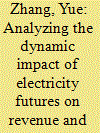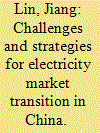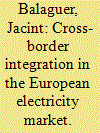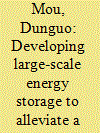|
|
|
Sort Order |
|
|
|
Items / Page
|
|
|
|
|
|
|
| Srl | Item |
| 1 |
ID:
091699


|
|
|
|
|
| Publication |
2009.
|
| Summary/Abstract |
While some agent-based models have been developed for analyzing the German electricity market, there has been little research done on the emerging issue of intra-German congestion and its effects on the bidding behavior of generator agents. Yet, studies of other markets have shown that transmission grid constraints considerably affect strategic behavior in electricity markets. In this paper, the implications of transmission constraints on power markets are analyzed for the case of Germany. Market splitting is applied in the case of congestion in the grid. For this purpose, the agent-based modeling of electricity systems (AMES) market package developed by Sun and Tesfatsion is modified to fit the German context, including a detailed representation of the German high-voltage grid and its interconnections. Implications of transmission constraints on prices and social welfare are analyzed for scenarios that include strategic behavior of market participants and high wind power generation. It can be shown that strategic behavior and transmission constraints are inter-related and may pose severe problems in the future German electricity market.
|
|
|
|
|
|
|
|
|
|
|
|
|
|
|
|
| 2 |
ID:
166944


|
|
|
|
|
| Summary/Abstract |
Though the electricity market in China has gone through several reforms in the last few decades, the market is still not completely liberalized. The wholesale prices are regulated and for renewable it is based on feed-in tariff; there is not yet a competitive spot or derivative market concerning the generation side. Furthermore, with great potential, renewable energy is being gradually promoted by the government to compete freely with conventional energies. However, it is hard for a renewable generator to survive without subsidy. So, in this paper we propose a new round of revolution in power sector to introduce electricity futures into China with the expectation of perfecting the market and providing a proper hedging tool for renewable plants. We make an estimation of the risk premium and then simulate the futures prices in China's market. To support the establishment of the futures contracts, we also propose two pricing mechanisms: Demand-side price & Opportunity cost price and study their effects on the futures. Finally, some suggestions with regard to the construction of futures market in China and the operational strategy for renewable plants are given.
|
|
|
|
|
|
|
|
|
|
|
|
|
|
|
|
| 3 |
ID:
124221


|
|
|
|
|
| Publication |
2013.
|
| Summary/Abstract |
Feed-in Tariffs (FITs) implemented by city councils in the USA have proven an effective means of stimulating installation of renewable-electricity generation capacity at a local level, and may also be effective for New Zealand cities. Though New Zealand has a high proportion of electricity generated renewably, this is mostly from centralized hydroelectricity plants. The suitability of city-level FITs for promoting solar photovoltaic panels in New Zealand is examined. Findings suggest that FITs, with rates obtained using the cost-of-generation method, could be implemented in New Zealand cities at rates comparable to those in successful FIT schemes internationally. The unique structure of New Zealand's liberalized electricity market, however, is likely to make financing FIT schemes at city-level more complex than the equivalent situation in the USA. Benefits of introducing such schemes will include the possibility for purchasers of solar PV systems to calculate returns on investment over the long term, and the streamlining of the grid connection process by reducing the number of authorities involved.
|
|
|
|
|
|
|
|
|
|
|
|
|
|
|
|
| 4 |
ID:
166408


|
|
|
|
|
| Summary/Abstract |
In 2015, ASEAN established a goal of increasing its renewable energy share in its energy portfolio from approximately 13–23% by 2025. Renewable electricity, especially intermittent and variable sources, presents challenges for grid operators due to the uncertain timing and quantity of electricity supply. Grid flexibility, the electric grid's ability to respond to changing demands and supply, now stands a key resource in responding to these uncertainties while maximizing the cost-effective role of clean energy. We develop and apply a grid flexibility assessment tool to assess ASEAN's current grid flexibility using six quantitative indicators: grid reliability, electricity market access; load profile ramp capacity; quality of forecasting tools; proportion of electricity generation from natural gas; and renewable energy diversity. We find that ASEAN nations cluster into three groups: better; moderately; and the least prepared nations. We develop an analytical ramp rate calculator to quantify expected load ramps for ASEAN in an integrated ASEAN Power Grid scenario. The lack of forecasting systems and limited electricity market access represent key weaknesses and areas where dramatic improvements can become cost-effective means to increase regional grid flexibility. As ASEAN pursues renewable energy targets, regional cooperation remains essential to address identified challenges. Member nations need to increase grid flexibility capacity to adequately prepare for higher penetrations of renewable electricity and lower overall system costs.
|
|
|
|
|
|
|
|
|
|
|
|
|
|
|
|
| 5 |
ID:
125399


|
|
|
|
|
| Publication |
2013.
|
| Summary/Abstract |
Growing climate change and energy security concerns are driving major wind energy deployment in electricity industries around the world. Despite its many advantages, growing penetrations of this highly variable and somewhat unpredictable energy source pose new challenges for electricity industry operation. One issue receiving growing attention is the so-called 'merit order effect' of wind generation in wholesale electricity markets. Wind has very low operating costs and therefore tends to displace higher cost conventional generation from market dispatch, reducing both wholesale prices and conventional plant outputs. This paper extends the current literature on this effect through an empirical study employing a range of econometric techniques to quantify the impacts of growing wind penetrations in the Australian National Electricity Market (NEM). The results suggest that wind is having a marked impact on spot market prices and, while wind is primarily offsetting higher operating cost gas generation, it is now also significantly reducing dispatch of emissions intensive brown coal generation. Great care needs to be taken in extrapolating these results to longer-term implications, however, the study does propose a methodology for assessing this effect, highlights the impacts that wind is already having on NEM outcomes and suggests promising directions for future research.
|
|
|
|
|
|
|
|
|
|
|
|
|
|
|
|
| 6 |
ID:
150068


|
|
|
|
|
| Summary/Abstract |
Electricity sector has been transformed from state-owned monopolistic utilities to competitive markets with an aim to promote incentives for improving efficiency, reducing costs and increasing service quality to customers. One of the cardinal assumptions of the liberalized and competitive electricity markets is the rational actor, and decision-makers are assumed to make the best decisions that maximize their utility. However, a vast literature on behavioral economics has shown the weakness of economic theory in explaining and predicting individuals’ decision-making behavior. This issue is quite important for competition in electricity markets in which consumers’ preferences have a significant role. Despite its importance, this issue has almost been neglected in Turkey, which has taken major steps in electricity sector restructuring. Therefore, this paper aims to examine switching and demand response behavior in Turkish electricity market by using multiple correspondence and panel data analysis, and findings are discussed in light of the neoclassical and behavioral economics literature. Analyses’ results show that consumers’ switching and demand response behavior is consistent with the neoclassical literature to some extent; however, behavioral factors are also affecting consumers’ decisions. Furthermore, there are systemic problems that hinder effective functioning of the electricity market and restrict competition.
|
|
|
|
|
|
|
|
|
|
|
|
|
|
|
|
| 7 |
ID:
099352


|
|
|
|
|
| Publication |
2010.
|
| Summary/Abstract |
Over the last three decades, privatization and restructuring of electricity sectors has been a hot topic. The expectation was that prices would fall due to increased competition and that generators would become more innovative and efficient. However, the enthusiasm for deregulation wavered after events such as the debacle in California, the fall of Enron and the setbacks of Ontario. In the Philippines, comprehensive legislation was passed in 2001 but the implementation has been rather slow and controversial. This paper looked at the allegation of politicizing power rates and found a logical alternative to the perceived conspiracy angle. Based on market data, it is highly probable that depressed market rates was a result of coping mechanisms of new players trying to adjust to the restructured industry.
|
|
|
|
|
|
|
|
|
|
|
|
|
|
|
|
| 8 |
ID:
177325


|
|
|
|
|
| Summary/Abstract |
We model the evolution of the Central Western Europe power system until 2040 with an increasing carbon price and strong growth of variable renewable energy sources (vRES) for four electricity market designs: the current energy-only market, a reformed energy-only market, both also with the addition of a capacity market. Each design is modelled for two decarbonisation pathways: one targeting net-zero emissions by 2040 for a 2 °C warming limit, and the other targeting −850 Mt CO₂ y‾ for a 1.5 °C warming limit. We compare these scenarios against the high-level objectives of delivering low-carbon electricity reliably to consumers at the lowest possible cost. Our results suggest that both 2 °C and 1.5 °C compliant systems could be achieved and deliver electricity reliably. In terms of cost, we find the 1.5 °C warming scenarios lead to system costs which are twice as high as the 2 °C scenarios due to the high cost of negative emission technologies – in particular direct air carbon capture (DAC). To make a 1.5 °C target more affordable, policymakers should investigate lower cost alternatives in other sectors, and increase research and development in DAC to reduce its cost.
|
|
|
|
|
|
|
|
|
|
|
|
|
|
|
|
| 9 |
ID:
168653


|
|
|
|
|
| Summary/Abstract |
China is currently pursuing electricity reforms that will create wholesale markets for electricity. Electricity markets hold considerable promise for facilitating China's transition to clean energy systems, but face obstacles. The most significant obstacle to market reforms is their potential financial impact on coal generation, which currently accounts for most of China's generating capacity. In this paper, we examine the impact of market reforms on coal generation in China, using Guangdong Province as a case study. We find that, in the near term, market prices are likely to lead to significant decreases in net revenues for coal generators relative to the current benchmark tariff, with 40%–60% of coal generation capacity unable to cover the cost of remaining in commercial operation. We estimate that existing coal generators in Guangdong had 94 billion yuan (US$14 billion) in outstanding debt in 2016, creating large risks for banks and raising questions about the potential impacts of electricity market reforms on China's financial industry. The impact of market reforms on coal generators creates two problems—transition and resource adequacy. The development of mechanisms for long-term resource adequacy provides a common solution to both of these problems.
|
|
|
|
|
|
|
|
|
|
|
|
|
|
|
|
| 10 |
ID:
125554


|
|
|
|
|
| Publication |
2013.
|
| Summary/Abstract |
Since the electricity market reforms of 2002, two large-scale power shortages, one occurring in 2004 and one in 2011, exerted a tremendous impact on the economic development of China and also gave rise to a fierce discussion regarding electricity system reforms. In this paper, the background and the influence scale of the two power shortages are described. Second, reasons for these two large-scale power shortages are analyzed from the perspectives of power generation, power consumption and coordination of power sources and grid network construction investments. Characteristics of these two large-scale power shortages are then summarized by comparatively analyzing the performance and the formation of the reasons behind these two large-scale power shortages. Finally, some effective measures that take into account the current status of electricity market reforms in China are suggested. This paper concludes that to eliminate power shortages in China, both the supply and the demand should be considered, and these considerations should be accompanied by supervisory policies and incentive mechanisms.
|
|
|
|
|
|
|
|
|
|
|
|
|
|
|
|
| 11 |
ID:
098622


|
|
|
|
|
| Publication |
2010.
|
| Summary/Abstract |
This paper investigates the competition effects of the entry of Vattenfall into the German electricity market. While the competition authorities supported the entry by approving Vattenfall's acquisition of three regional utilities, other market participants raised concerns over the emergence of an upcoming oligopoly in the German market for power generation. We contrast the efficiency hypothesis postulating pro-competitive effects of mergers with the market power hypothesis postulating anti-competitive effects. For the analysis of the two opposing hypotheses, we use an event study approach to the stock prices of Vattenfall's competitors in the German market. While we find no empirical evidence for increased market power in the German electricity market due to Vattenfall's mergers, there is some indication for efficiency increases. We therefore cannot oppose the view of the competition authorities predicting an overall positive effect for consumers as a result of Vattenfall's entry into the German electricity market.
|
|
|
|
|
|
|
|
|
|
|
|
|
|
|
|
| 12 |
ID:
149934


|
|
|
|
|
| Summary/Abstract |
In European countries, retailers are obliged to disclose the energy source and the related environmental impacts of their portfolio over the preceding year. The electricity supplied in the Dutch retail market is presented as renewable energy for 34%, but this relatively high share is for 69% based on certificates (Guarantees of Origin) which are imported from in particular Norway. The certificates are used to sell green electricity to consumers. The premium for green electricity which is actually paid by Dutch consumers is no more than a few percentages of the retail price. The low level of this premium is related to the abundant supply of certificates at low marginal costs from Norway. This also means that the premium for green electricity is too low to give an incentive for investments in new capacity. Hence, the current labelling system for renewable electricity is mainly valuable, besides being an instrument for tracking and tracing of renewable energy, as a marketing instrument for electricity retailers. The effectiveness of Guarantees of Origin as a policy instrument to foster renewable electricity sources is weak. This effectiveness can be raised by implementing restrictions on the international trade or the issuance of new certificates.
|
|
|
|
|
|
|
|
|
|
|
|
|
|
|
|
| 13 |
ID:
109314


|
|
|
|
|
| Publication |
2011.
|
| Summary/Abstract |
This paper examines the electricity market integration process in two European areas based on the pricing behavior of Norwegian and Swiss exporters. The aim is to gain evidence for the period after the adoption of the "Second Legislative Package" (2003). The pricing behavior of Norwegian exporters indicates that the wholesale markets for Denmark and Sweden are highly integrated. Moreover, results are fully compatible with the existence of a very competitive marketplace for electricity. This clearly contrasts with the evidence provided by Swiss exporters. In this last case, analysis revealed differences in pricing-to-market behavior between Italy, France and Germany, which indicates that exporters take advantage of international market segmentation and divergences between market structures. This outcome provides a reasonable explanation as to why price differences between countries cannot be fully attributed to transmission costs, as has been claimed in previous research. We also found cross-country convergence in levels of markups and in pricing-to-market behavior of the Swiss exporters for the first part of the period that was analyzed. The evidence is fully consistent with an initial impulse toward market integration originated by reforms implemented at the beginning of the last decade.
|
|
|
|
|
|
|
|
|
|
|
|
|
|
|
|
| 14 |
ID:
166934


|
|
|
|
|
| Summary/Abstract |
By taking the grid system in Fujian Province as an example, this paper establishes a power market system model to simulate the impact of nuclear and wind power on the system operation. The article employs the method of optimal power flow (OPF) analysis, under a framework of social welfare maximization with close-to-reality thermal power generation cost and technical constraints. The simulation results show that large-scale nuclear power can reduce the level of electricity prices and improve the difference in regional electricity prices; as a result, the thermal power can be in an unfavourable position and therefore undertake peak and load following; meanwhile, the development of large-scale wind power would increase the demand for following of load and valley load. Moreover, the simulation for the operation of the electricity market shows that in the case of electricity oversupply, the thermal power can be deliberately bid at a low price, and the nuclear power would assume the obligation of valley load following, even with the presence of PSHPs in the system; thus, the low-carbon energy can't be fully utilized. In conclusion, the general bidding model in the electricity market cannot be applied to the situation of long-term electricity oversupply.
|
|
|
|
|
|
|
|
|
|
|
|
|
|
|
|
| 15 |
ID:
132621


|
|
|
|
|
| Publication |
2014.
|
| Summary/Abstract |
The Australian Renewable Energy Target (RET) has spurred significant investment in renewable electricity generation, notably wind power, over the past decade. This paper considers distributional implications of the RET for different energy users. Using time-series regression, we show that the increasing amount of wind energy has placed considerable downward pressure on wholesale electricity prices through the so-called merit order effect. On the other hand, RET costs are passed on to consumers in the form of retail electricity price premiums. Our findings highlight likely significant redistributive transfers between different energy user classes under current RET arrangements. In particular, some energy-intensive industries are benefiting from lower wholesale electricity prices whilst being largely exempted from contributing to the costs of the scheme. By contrast, many households are paying significant RET pass through costs whilst not necessarily benefiting from lower wholesale prices. A more equitable distribution of RET costs and benefits could be achieved by reviewing the scope and extent of industry exemptions and ensuring that methodologies to estimate wholesale price components in regulated electricity tariffs reflect more closely actual market conditions. More generally, these findings support the growing international appreciation that policy makers need to integrate distributional assessments into policy design and implementation.
|
|
|
|
|
|
|
|
|
|
|
|
|
|
|
|
| 16 |
ID:
133213


|
|
|
|
|
| Publication |
2014.
|
| Summary/Abstract |
This paper estimates the relationships between bidding quantities, marginal cost and market power measures in the Spanish wholesale electricity market for two different regulatory periods: 2002-2005 and 2006-2007. Using panel econometric techniques we find differences in the impacts on bidding strategies for both periods. Hence, the marginal cost and the market power measures affect bid and net quantities. The market power measures also suggest that the coefficient is consistently positive and highly significant for both periods.
Moreover, the market power and marginal costs have mixed effects according to the models proposed for both periods. In addition, our results point to the effectiveness of the different effects of mitigating the market power in the Spanish electricity market. For the 2006-2007 period, the proposed causal relationships are partially validated by the cointegration results, which assumes there is a significant causality between the Lerner Index and the marginal cost.
|
|
|
|
|
|
|
|
|
|
|
|
|
|
|
|
| 17 |
ID:
092564


|
|
|
|
|
| Publication |
2009.
|
| Summary/Abstract |
An efficient electricity double-sided auction mechanism should control market power and enhance the social welfare of the electricity market. Based on this goal, the paper designs a new double-sided auction mechanism. In the new mechanism, the social welfare contribution of each participant plays a pivotal role, because this contribution is the critical factor in market clearing, payment settling, and transaction matching rules. In particular, each winner of the auction can gain transfer payments according to his contribution to social welfare in the electricity market, and this gives the mechanism the ability to control the market power of some participants. At the same time, this mechanism ensures that the market organizer balances his budget. We then conduct a theoretical and empirical analysis based on the Spanish electricity market. Both of the results show that compared to the uniform-pricing mechanism, the new mechanism can reduce market power of participants and enhance the social welfare of the electricity market.
|
|
|
|
|
|
|
|
|
|
|
|
|
|
|
|
| 18 |
ID:
094841


|
|
|
|
|
| Publication |
2010.
|
| Summary/Abstract |
In 2004, the reform of the Brazilian Electricity Market underwent a thorough revision. One of its causes was the electricity rationing that began in June 2001 and lasted until February 2002. Among other measures, the 2004 revision devised new mechanisms intended to reduce risks associated to contracts settled in electricity auctions and those related to investments in new generation plants. As 4 years have passed since the onset of the reform's revision, sufficiently enough data are now available for an analysis of the post-revision dynamics of the Brazilian Electricity Market. This is the purpose of the present paper. We focus on the dynamics of the different types of electricity auctions and on the so-called Mechanism for Compensation of Surpluses and Deficits, both created in the wake of the 2004 revision. The ultimate goal is to understand the behavior of the agents involved in auctions - notably buyers and sellers of electricity - and propose remedial actions to eliminate existing loopholes in the present regulatory framework. To achieve this goal, four steps were necessary. Firstly, a data base to support the analysis was built. Then, the main drivers of the dynamics of the risk management tools were identified. Finally, consequences of the implemented changes were discussed and corrections for observed pitfalls proposed.
|
|
|
|
|
|
|
|
|
|
|
|
|
|
|
|
| 19 |
ID:
124376


|
|
|
|
|
| Publication |
2013.
|
| Summary/Abstract |
The aim of this paper is to show the economic potential of demand response (DR) on household level at Central European market conditions. Thereby, required economic benefits for consumers' participation, the realistic load shifting potential at household level and the estimation of essential intelligent infrastructure costs are discussed. The core of this paper builds a case-study applying spot market-oriented load shifting from the supplier's point of view by using Austrian electricity market data, household load profiles as well as a heat pump and e-car charging load profile. It is demonstrated which cost savings for suppliers can be derived from such load shifting procedure at household level. Furthermore, upper cost limits for intelligent infrastructure in order to break-even are derived. Results suggest to take a critical look at European discussions on DR implementation on household level, showing that at Central European market conditions the potential for DR at household level is restricted to significant loads and hence, the applied load shifting strategy is only beneficial with application to heat pumps. In contrast, the frequently discussed shifting of conventional household devices' loads (such as washing machines) economically does not add up.
|
|
|
|
|
|
|
|
|
|
|
|
|
|
|
|
| 20 |
ID:
150870


|
|
|
|
|
| Summary/Abstract |
Following liberalization reforms, the ability of power markets to provide satisfactory incentives for capacity investments has become a major concern. In particular, current energy markets can exhibit a phenomenon of investment cycles, which generate phases of under and over-capacity, and hence additional costs and risks for generation adequacy. To cope with these issues, new mechanisms, called capacity remuneration mechanisms (CRM), have been (or will be) implemented. This paper assesses the dynamic effects of two CRMs, the capacity market and the strategic reserve mechanism, and studies to what extent they can reduce the investment cycles. Generation costs and shortage costs of both mechanisms are also compared to conclude on their effectivity and economic efficiency. A simulation model, based on system dynamics, is developed to study the functioning of both CRMs and the related investment decisions. The results highlight the benefits of deploying CRMs to solve the adequacy issue: shortages are strongly reduced compared to an energy-only market. Besides, the capacity market appears to be more beneficial, since it experiences fewer shortages and generation costs are lower. These comparisons can be used by policy makers (in particular in Europe, where these two CRMs are mainly debated) to determine which CRM to adopt.
|
|
|
|
|
|
|
|
|
|
|
|
|
|
|
|
|
|
|
|
|